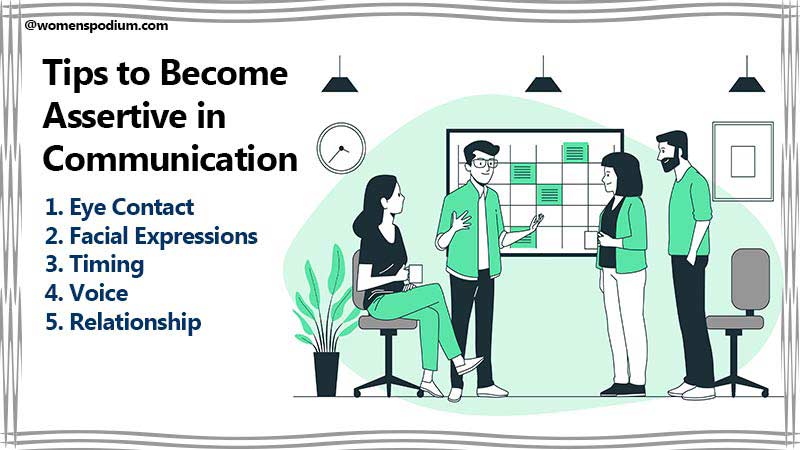
Assertive communication is extremely important in everyday life. Good communication is the bridge between confusion and clarity. Be it with our family, friends, relatives, or even colleagues, assertive and polite communication is an art we all need to master. According to the APA Dictionary of Psychology, communication is defined as ‘the transmission of information, which may be by verbal (oral or written) or nonverbal means (see nonverbal communication).’ As humans, we communicate for a wide variety of reasons – from exchanging ideas and thoughts to describing our deepest feelings and emotions; communication carries us through it all. Communication helps us deepen and enrich our relationships, and every new style of communication we master allows us to represent ourselves and our innermost world in the best way possible.
The Importance of Communication Skills in Everyday Life
Besides being an essential aspect of our personal and social lives, communication holds high value in our professional lives as well. It is an important soft skill, and in today’s world, it has become an indispensable asset along with a polished resume. Various research available worldwide shows that employers still consider communication skills a necessary prerequisite to hiring their employees. Therefore, not only are communication skills essential in personal life, they are absolutely irreplaceable in our professional lives as well.’
Types of Communication
Now that we know how important communication is, we can explore the different types of communication. Verbal, non-verbal, written and symbolic communication are some of the basic types of communication. However, communication does not just involve words. Communication is a beautiful amalgamation of words, voice, tone, vibe, feelings, emotions and context. Depending upon the variations in these factors, different messages are communicated differently. As humans, we communicate in innumerable ways, which gives rise to a wide variety of types of communication. There are basically three types of communication namely assertive, passive and aggressive communications that we use most of the time while communicating.
1. Passive Communication

Passive communication is one in which people are indirect in expressing their views. They are self-denying and emotionally dishonest. Being passive in communication involves a lot of behaviors. However, a passive communicator usually avoids confronting situations, does not clearly express his needs, and does not communicate in a way that the other person understands. Passive communication also involves ghosting, ignoring, stonewalling, giving the silent treatment etc. The most gruesome downside of this kind of communication is that it does not allow the situation to progress and causes relationships to get stagnant. If prolonged, passive communication can build deep rifts and cause irreparable emotional, psychological and even tangible damage to relationships, and well as to the communicator themselves.
2. Aggressive Communication

In aggressive communication, people are much demanding and forceful in whatever they say. Their main motive is to win at any cost. Aggressive communication involves behaviors that put the communicator in a dominant position. Yelling, screaming, shouting, even physical violence are some examples of aggressive communication. Aggressive communication causes an increase in conflict or causes the other person to shut down completely. This kind of communication overcompensates where passive communication fails. It establishes a clear power hierarchy in the relationship, making it toxic and potentially harmful in the long run.
People with aggressive behavior use raised voices, strong language, and they are very pushy in whatever they speak. When talking about children, it is a must to guide them at an early age if they grow up in a hostile or abusive environment. They might use more rude and aggressive words in their communication later on when they grow up. Lack of affection and attention at a young age can affect a child’s social skills and snatch their self-esteem.
Also Read: Aggressive communication can lead your relationship into a toxic relationship with your family, spouse or children further leading to uninvolved parenting.
These were two of the most used yet most ineffective communication styles when two mindful individuals are communicating. Both of these communication styles are deeply one-sided and do not solve the very purpose of communication. Then, is there a better way to communicate? The answer lies in the third style of communication.
3. Assertive Communication
Being able to communicate assertively is essential in strengthening the relationship. Being assertive in communication means you can express your ideas sincerely and directly. Assertive communication is the perfect balance between gentle and firm. It opens up channels and communication and creates a safe space for expressing thoughts, feelings and opinions. Assertive communication is respectful, acknowledges the framework of personal boundaries, and does not provoke conflict, contempt, criticism or stonewalling. It allows people to understand each others’ needs and goals and work together regardless of the relationship they share.

So, What Exactly is Assertive Communication?
According to the APA Dictionary of Psychology, assertiveness is ‘an adaptive style of communication in which individuals express their feelings and needs directly while maintaining respect for others.’ Assertive communication invites a great degree of self-awareness and empathy toward others. In most professional and personal settings, assertive communication proves to be the best style of communication.
How to Build an Assertive Style of Communication?
We are often told that assertive communication needs a particular body language, vocabulary, or action. However, not everyone is born with assertive communication skills, and that is the beauty of communication. Based on our culture, history, background, and narrative, we can learn to communicate assertively with the people around us in a way that honors our relationships. Assertiveness can look different in different settings, and therefore, there are no set tenets of behavior that are considered to be always assertive. Here are a few tips that can help you figure out what assertive communication looks like.
1. Introspect

Communication begins long before we voice out something to another person. It begins the moment we think about something that needs to be communicated. So, take the time to sit with yourself and introspect – what is it that you really want or need? What is it that you want to tell this other person? Does this thing that you need require you to communicate it, or do you think it would be better first to do some self-work? Only when you’re sure that you want to communicate something, then you are ready to go and voice your opinion to others.
Take the time to also think about your expectations from the other person. If it is a problem you are communicating, do you want them to listen to you, do you want them to give you solutions, or do you want them just to hold space for you? Assertive communication does not always need to have strong language or a firm demeanor. Most of the time, just having a clear intention works just fine.
2. Take The Time to Feel Your Feelings

How often have you lashed out in anger, only to regret it later? Whether it is anger, sadness, grief, happiness, joy, ecstasy, or anything else. Take the time to fully process what you are feeling. When you know what you are feeling and where that feeling is coming from, you can effectively communicate that to the people around you. Knowing what you’re feeling allows you to take control of your actions instead of letting your emotions take the driver’s seat.
3. Do This Everyday

Sitting with yourself or processing your emotions does not have to be a grueling task. Rather, is it something that needs to be done every day. If we cannot communicate with ourselves effectively, and if we cannot train ourselves to listen to what we are feeling, then how can we ever communicate effectively with another person? When we take the time to listen to ourselves regularly, we can truly show up as the truest version of ourselves, comfortable in our own skin. With that, we also give others the opportunity to feel comfortable in their skin. So, communication then becomes an exercise in constant empathy and self-compassion, instead of a soft skill that we need to develop for that job!
Some Tips to Help You to Become More Assertive in Communication
Assertive communication is important whether you are at the workplace or at home. It helps you to feel good about yourself and others. Sometimes we are not able to convey the messages that we want to share. We think that the listener might get upset and disappointed with our words. You have to realize that you will feel more frustrated within yourself if you do not speak out. In this case, put yourself in his shoes and think of the situation. How will you react if the exact words are being delivered to you? If you are satisfied with the answer, speak out politely without hurting or alienating other people.
Observe your language and way of speaking. Your speech should perfectly express your requests without blaming others. Body language also plays a vital role in how other people treat us. You should keep the following things in your mind to be assertive while communicating.
1. Eye Contact

Eye talks! Ensure to make eye contact with the person you are talking to, but do not stare at the people. Your eyes shouldn’t look like you are trying to read the minds, even not letting others read yours when communicating. You will indeed feel the differences in the quality of communication.
2. Facial Expressions

Your facial expression should match your every emotion. For example, when you are expressing something funny, your expressions must match. And in case it is a serious issue, you shouldn’t be smiling or look casual; it will ruin the gravity of your topic and make it less effective. If you are someone who encounters issues with facial expression, then try to practice it. Use a mirror to practice and see how you look when you are expressing anger, happiness, fear, and other emotions. Facial expressions and gestures help to emphasize your speech, especially when addressing a group.
3. Timing

Timing also plays a significant role in communication; analyze the surroundings and situations before speaking. Some people just talk about anything without giving it a thought. Always comprehend the right timing and place to address any concerns; it will directly influence the listener.
4. Keep Checking your Voice Tone

The tone of your voice leaves a significant impact on the listeners. A raised tone of voice relates more to aggressive behavior. You must keep your voice steady. It should be at the level where it sounds most convincing and acceptable and shouldn’t be intimidating at all. Sometimes it becomes tough to control anger, yet try to be calm as a sophisticated tone can resolve the issues much better than aggression. Working on your tone and speaking skills with people around you will undoubtedly tame your behavior if it is rude.
5. Believe in your Relationship

Most of the time, we see that non-assertive people fail to express any kind of emotions with their partners. It is very frustrating for the person when they cannot tell what they need from each other. They have a fear in mind about their partner’s reactions. They face the same situations among friends and colleagues. So try to open up to your partner, friends, and colleagues; it indeed will help you understand them better, leaving misunderstandings behind.
These were some tips to find out what assertive communication looks like from your vantage point. However, do remember that this is not an exhaustive list. Different situations demand different kinds of communication styles – including passive or aggressive communication or even different methods of assertive communication. So inevitably, effective communication comes from self-awareness, and it begins inside us, just as much as it shows up outside us! In the end, we just want to communicate in a way that makes us feel represented adequately and deepens understanding in our relationships.
Also Read: Whether or not you are assertive in communication, there is no need to be disrespectful or hate each other. Always value respect in your relationship.






